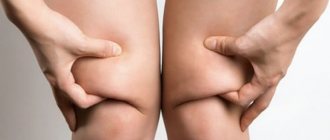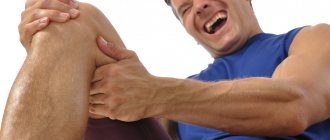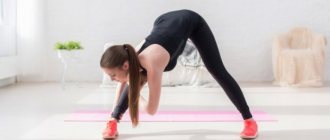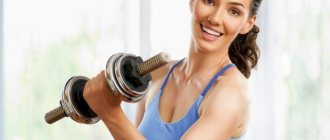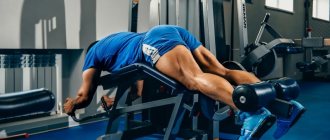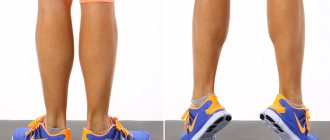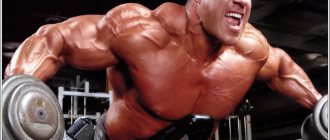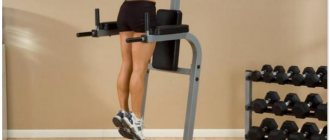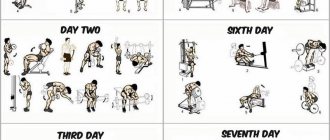How to make your calves smaller: why are your calves full?
The cause of voluminous calves may be a genetic predisposition, a hypersthenic physique, with a dense, stocky figure. If this is the case, losing weight on your calves will require more time and persistence. Enlarged calf muscles may be associated with leg swelling caused by fluid retention or varicose veins. In this case, the legs get tired, and in the evening they feel heaviness and burning. The muscle mass of the legs in such cases is loose and not expressed. Excessively thick calves are a result of excess weight and uneven weight loss. The body both loses weight and gains weight disproportionately. When losing weight, volumes primarily disappear from the neck, arms and chest. And problem areas retain their roundness, despite diets. Long-term, persistent strength training can also give your calves volume and definition.
Proper diet
If you've been eating mostly pure protein to gain muscle mass, now is the time to switch to plant fibers and fats.
How to get rid of excess pumped up muscles in the legs with the help of nutrition? Include in your diet more vegetable and fruit salads rich in fiber, as well as vegetable oils that are rich in vitamin E and also retain fluid in your body. This is so important for the elasticity of all tissues, including muscles.
Oats are very useful in this regard. It can be consumed not only in porridges, but also in the form of jelly, and also brewed overnight in a thermos and then drunk; use for making diet cakes, mixing with yogurt with the addition of fresh and dry fruits.
Try to consume more plant-based protein, and have “fish days” twice a week, just choose lean fish. Instead of red meat, opt for chicken breasts. Boiled or grilled, cut into pieces and added to fresh salads - this is an excellent nutritious and dietary dish! Don't be afraid of brown rice sides.
After training, refrain from eating dense food for 2 hours, you can drink juices and eat fruits (except bananas). Drinking yogurt won't hurt either. Before training, eat an apple or two - this is the best plant source of energy. Try to forget about special protein bars and shakes forever - if you want to look feminine, choose natural ones!
Read more: Hyperextension technique performed in the simulator what muscles work
Note! You need to eat at least 4 times a day, and the basis should be non-thermally processed vegetables and fruits, as well as complex carbohydrates.
Don’t chase the routines and splits of fitness and bodybuilding stars, you can use them on yourself, but listen to your body, feel it, don’t stupidly follow a certain list of exercises, change them and adjust them to suit you. Pay special attention to:
- How tired do you get during training?
- How long does it take to recover after training?
- Strive to feel the muscle, not just work out the exercises
How to reduce calf size
If the fullness of the calves is associated with fluid retention, it is necessary to limit the consumption of salt, pickled and smoked foods. All this can lead to swelling of the legs and provoke vascular diseases. You can get rid of excess weight and fat legs by reviewing your diet. It is best to turn to a balanced diet, so you can achieve excellent results and maintain health. To do this, you need to include fresh vegetables and fruits and low-fat dairy products in your diet. You shouldn’t worry that the weight will come off slowly, the main thing is that it doesn’t come back quickly. At the same time, you need to adjust your drinking regime and move more.
To reduce calves on the legs after losing weight, it is recommended to perform special sets of exercises. At the same time, it is good to do several exercises to stretch the muscles, then they will become elastic and toned. The calves are very strong and resilient muscles; they help us move all day long without getting tired. That is why they are difficult to correct. To change their form, training must be systematic, 2-3 times a week. Calf muscles that have become bulky as a result of exercise can be tightened by regularly stretching this area.
Exercises
Getting rid of voluminous calves on the legs is quite difficult, because in such an area the fat layer is minimal, so the structure and shape are determined by the calf muscle. The fat layer often increases in size, especially during the cold season, but with regular walking, the calves quickly regain their previous slimness and attractiveness. Therefore, the best way to combat this problem is to walk long distances. By the way, such physical activity is suitable for all people, regardless of their level of training.
Stretching exercises to reduce calves
- Sit on the floor. Bend forward, touching your fingers to your toes. Pull your heels away from you and your toes toward you. It will seem difficult at first, but gradually your flexibility will increase and you will be able to perform the exercise with ease. Stretching is carried out at a smooth pace. Hold the pose of maximum tension for a few seconds. Repeat the stretch 3 times. This exercise must be performed on each leg separately. The starting position is the same, spread your legs in different directions.
- Standing straight, lunge forward with your left foot. Bend it at the knee. The foot of the right leg is pressed tightly to the floor, stretching occurs due to its muscles. Hold the position for a few seconds. Using the same technique, perform the exercise with a lunge of the right leg. Repeat 3-5 times with each leg.
- Stand facing the wall at arm's length. Place your feet shoulder-width apart, do not raise your heels. Bend your body towards the wall, leaning on it first with your palms, then with your forearms, and finally with your shoulders. Feel the stretch in the muscles above the heel. Perform 3-5 times.
- Basic yoga pose: Downward Facing Dog. Starting position: stand on all fours. Slowly straighten your knees, lifting your torso. Leave your legs slightly bent at the knees, feet resting on your toes, face directed towards the floor. Do not lift your heels high from the floor, this is when the calf muscles are stretched. Stay in this pose for several seconds. Repeat 3-5 times.
- There are other exercises in the yoga system for stretching the calf muscles, so include them in your morning exercises and make your legs graceful. If you inherited fat calves, you can combat this by doing yoga. It is better to master yoga techniques from a professional instructor; if this is not possible, use video lessons.
- Pilates helps you stretch your muscles and lose weight at the same time. This is a muscle stretching technique based on static exercises.
How muscles really grow.
I decided to share, although it’s not mine, but brazenly stolen)
I’m surprised that everyone around me thinks so. This is what they say on TV in any program about bodybuilding, and this is what is commonly believed all over the world. But has no one thought about the very essence of this statement? What micro-tears?! What are we talking about??
There are many contradictions in this theory. Let's take a closer look at them.
If you believe this theory, you can draw the following conclusion: at the very first workout, I need to take the maximum weight on my biceps and pump-pump-pump it. Over time it will begin to grow. But many of us have tried this method. When I was 16 years old, I found 2 dumbbells and started doing biceps curls 3 times a week. I did this for about 2 months, my muscles hurt, but there was no growth. Why? I made micro-tears! Where is the growth??
If we follow this crazy statement, it turns out that muscle mass will grow regardless of what program we follow. It is important to make micro-tears in the muscle fibers and let them heal. That is, you can study without a program at all! What nonsense? Why then are there so few people around us who have achieved success in gaining muscle mass and have an athletic physique?
Some will say, genetics is not the same. But this is bullshit. Genetics only determines the speed of muscle gain. That is, if you are 180 cm tall and weigh only 60 kg, then in 3 months you will not be able to pump up more than 8-9 kilograms of muscle mass.
What kind of genetics can we talk about if, with a height of 180 cm, I weighed only 62 kilograms and could never gain weight, and now, after I started training and completed training in my programs several times, I weigh 86 kilograms. Moreover, I have practically no fat.
That is, in total, I gained 24 kilograms of muscle mass. — Weak genetics? No, have not heard! ))
This is all bullshit. I repeat: genetics determines only the speed of muscle mass gain. Genetically gifted guys gain muscle faster, while skinny and wiry guys gain muscle more slowly. That's all. The gain of muscle mass is determined not by genetics or micro-tears, but by the correct program, which provokes the release of hormones.
For the first time I thought about the delusion of this statement when I was studying the work of the human body. Later I trained a guy named Victor. He had problems with his knee joints (after an accident), so I trained him with my M4 program (which does not put stress on the legs and is suitable for the disabled).
During the training, he did not use his legs. But after 3 months, the muscles in his legs increased significantly in size. Paradox, isn't it?
Then I observed similar cases several more times. And now I train myself according to my new R1 program and do not put any stress on my legs at all. Nevertheless, the muscles are growing. Although I don’t want this (they are over-pumped). Also, I've never done any trapeze exercises, but they're quite big. Deadlifts work the trapezius, but I haven’t done it for a long time (to keep my legs from swinging), but my trapezius is still growing.
That is, there are no microtears, but the muscles grow. What's the catch?
Another inexplicable phenomenon: why do girls lift weights, put a serious strain on their muscles, they hurt, but don’t grow? After all, there are microtears, but for some reason there is no growth!
And the last question: why do basic exercises grow muscles, but isolated exercises only burn fat?
These questions cannot be answered if you adhere to the generally accepted theory of muscle growth. It is unfounded, contradictory and delusional. Now I will explain why.
I already wrote this in the “Myths and Reality” section of the book “Home Training - Maximum Freedom” and I will write it again: hormones build muscles. Whether you like it or not, the fact remains a fact.
The training program only stimulates the production of hormones that build muscles and cyclically loads the fibers so that the body has the need to thicken them. This is how muscle growth occurs.
If you train correctly, then you give a basic load to several muscle groups at once. From such a load, the body begins to secrete the male sex hormone testosterone, which, with the participation of growth hormone and IGF-1, begins to strengthen muscle fibers in order to protect the muscles from overload.
That is, the body prepares in advance for the fact that a repeated load will be placed on its muscles, and it prepares the muscles by increasing muscle mass.
During rest, we consume large amounts of protein, and testosterone thickens muscle fibers with this protein. That is, protein serves as a building material for thickening muscle fibers. In other words, muscles grow not from microtears, but from thickening of fibers.
That is why the muscles have a uniform, rounded shape, and do not become lumpy from microtrauma.
At the next workout, we increase the weight in the exercises so that the body begins to prepare the muscles for the next workout, because the weight is constantly growing and therefore the muscles must thicken, otherwise the body will not cope with the load.
Therefore, if you constantly exercise with the same weight, the muscles do not grow.
1. Why don’t muscles grow in men who have problems with the production of male sex hormones, and in women?
2. Why, if you only pump your biceps from month to month, there is no growth?
3. Why does growth stop if you lift the same heavy weight?
4. Why don’t muscles grow from isolated (single-joint) exercises?
Your “expert” will not be able to provide a single valid argument. The answer to all these questions is simple: hormones build muscles.
I have always been interested in human physiology. I was incredibly interested in understanding how our body works. After all, this is the most perfect system in the world. One day, while studying the effects of hormones on the body, I learned that there is a hormone called cortisol, which is stressful. One of cortisol's jobs is to destroy muscles. This is why people lose weight during times of severe stress and depression. Their muscles are destroyed.
Read more: How to properly stretch muscles, the best tips and exercises for stretching muscles and joints
Then I made the biggest discovery in my life: any training is stress for the body, and the longer we do it, the more cortisol the body releases. This is a scientific fact.
This conclusion formed the basis for all my training systems. This is why not a single workout in my programs lasts longer than 50 minutes. It is useless to study longer. During training, we simply give a powerful basic load and go eat protein. The hormones themselves will build muscle.
Why is it so important to understand all this? It's simple - you're always tempted to add a couple of exercises for the abs or biceps! ) There’s just no point in it. On the contrary, you do harm by provoking the body to secrete cortisol.
source
Exercises to reduce fat calves
If you are concerned about the problem: how to reduce fat calves, do squats, this is a very simple and effective remedy. Squats performed systematically will significantly reduce the size of your calves if done correctly:
- do not use additional weight, this can lead to enlargement of the calf muscles;
- perform one half of the squats while standing on your entire foot, and the second half on your toes;
- do not do very deep squats, a half squat is quite enough.
- Stand up straight, straighten your shoulders. Perform 30-40 squats at a slow pace, fixing the position for a few seconds in a squat.
- The next version of squats: feet shoulder-width apart, toes pointing inward. Perform shallow squats 20-30 times.
- You can reduce your calf size by walking on tiptoes. Try to walk on your toes more at home, at the same time you can improve your posture and feel like a princess.
- Rising on tiptoes. Place a chair with a back in front of you, put your hands on the back. Rise onto your tiptoes slowly, holding in the highest position for 2-3 seconds. Gradually lower your entire foot. Perform 30-40 times.
- Walking up the stairs will help burn fat deposits in the calf area by activating metabolic processes in this area. To do this, walk up the stairs every day for 10-15 minutes.
- Jumping rope will help make your legs slender. This is a great activity for both the legs and the cardiovascular system. Intense exercises with a skipping rope for 10 minutes will correct your silhouette and reduce the size of the calf muscles. When starting this simple exercise, be careful not to overdo it. Start with a few minutes, this will help avoid pain. Then you can increase the training time. In subsequent workouts, add jumps on each leg in turn.
Is it possible to reduce calves on the legs and how to do it correctly
Taking care of your appearance is a matter of principle for every girl, because dissatisfaction with her appearance can truly poison her life. Endless diets, trips to beauty salons and gyms have become an integral part of life. However, if some “problem” areas are quite easy to correct, then others have to constantly work hard to give the desired shape. Having a perfectly flat stomach, beautiful arms and toned buttocks, many girls simply lose their temper, not knowing how to reduce the calves on their legs.
It would seem that such a minor drawback, however, in order to correct it, you need to train almost daily, and the types of exercises will differ radically depending on the causes of the problem. By the way, there are three of them: swelling, excess weight and pumping of the calf muscles. But if in the first case you should quickly consult a doctor and change your diet, then in the other two you need to work hard on yourself. As you may have guessed, this article will be about how to reduce calves on your legs for girls.
Working on pumped calves
This problem most often arises due to improper loads while walking or playing sports, when instead of placing emphasis on the heel, it is placed on the toe. Another very common reason is wearing heels, especially high heels. Yes, yes, they not only put stress on the back and pelvis, but as a result of constantly walking in an unnatural position of the foot, the calf muscle also suffers. Therefore, the first thing you should take a closer look at is your own gait, because it really can be the root of the problem.
During any movement, try to control that the load is evenly distributed between the heel and toe, not limited to the latter. Otherwise, the muscles will continue to pump up, and the lower part of the leg will become more and more shaped like an inverted bottle. Maybe it’s okay, but you’ll just have to be more picky about your outfits, especially if it concerns a light short dress or a miniskirt, and tight jeans don’t look the best on those legs.
So what should you do to reduce your calf size? A real find for those who want to get rid of this problem will be an elliptical trainer, the use of which helps to lengthen the muscle, and therefore reduce its volume. Regular long walks will also bring great benefits, and your route needs to be thought out in such a way that it runs on a flat surface, without climbing steep hills. By devoting at least half an hour to this every day, you can bring yourself significantly closer to the desired result. The same route can be used for cycling or marathon running, the main principle is the absence of sharp climbs. Another option for dealing with voluminous calves is swimming.
However, in addition to training, you should also remember a number of restrictions that should be strictly observed. This applies to both training and everyday life. Exercises for losing weight in the calves are in no way compatible with sports such as mountaineering or sprinting, since they are the ones that maximally load and enlarge these muscles. Jump ropes, step, calf raises - all this will also have to be abandoned. Well, running on rough or hilly terrain is also not the best option when dealing with volume in the calves.
Fighting fat calves
Excess weight, as a rule, is reflected in absolutely all areas. The problem is that it goes away absolutely unevenly, and even ladies who have lost a fair amount of weight, having acquired the much desired shape, remain the “lucky” owners of disproportionately thick calves. But even such a difficult problem can be dealt with, and you need to believe that since you managed to get the perfect waist, you will also have enough patience for your calves.
Before you begin exercises to lose weight in your calves, you need to understand that no one has canceled the diet, because there is still excess fat left. True, it can still be adjusted by making it less strict. The training itself will be aimed at pumping the muscles, so they are the opposite of the previous recommendations. The set of exercises must include jumping rope, toe raises, squats, and step aerobics. In everyday life, you need to walk on steps as much as possible, climb slides and hills, and the main emphasis should be on your toes. Now let's look at the technique of doing the exercises in more detail.
Jump rope. In childhood, our willingness to jump with this sports equipment seems limitless, but in adulthood this potential is practically zero, so it is better for beginners to start these workouts with a very short period of time - only 30 seconds, after which they gradually increase the intervals. It is worth noting that they will only be effective if the jumps are performed on the toes. The order of jumps is as follows: 10 on two legs, 10 on one, 10 on the other. Start with one approach, gradually increasing their number.
Toe raises. A set of these exercises for losing weight in the calf muscles should be performed at the following pace: 10 slowly, 10 faster and 10 springy without stopping.
- Exercise 1. Legs hip-width apart, feet parallel to each other.
- Exercise 2. The position is the same, heels together, toes apart.
- Exercise 3. Same position, toes together, heels apart. This is the most difficult of the proposed ones, since it is quite difficult to maintain balance. Therefore, you can take a chair or lean against a wall for support.
Squats. The peculiarity of such squats is that the main effect will be achieved by lifting on your toes in a sitting position. The algorithm is as follows: squat down, rise on tiptoes, fix the position, stand up. The back should be as straight as possible, it is better to keep your hands in front of you. You need to start with at least 5 squats, gradually increasing the number to 20.
Stretching. A familiar exercise to us from school: sitting, legs straight in front of you, lean forward as much as possible, pulling your toes towards you with your hands. When you feel maximum tension, hold the position for 10 seconds, then return to the starting position. The number of repetitions is from 3 to 5.
Having risen to the maximum height on your toes, try to walk around the room in this way for at least a minute and a half, this will also give your muscles a good stretch.
For those who are more prepared, you can use the downward-facing dog yoga pose. From a lying position, stand up with your feet and hands on the floor, so you need to bring your silhouette as close as possible to the Latin letter “V”. Fix in this position for 20-30 seconds, try not to lift your heels off the floor.
All these exercises must be performed systematically for at least three months, after which the results will become noticeable. Therefore, it’s hardly worth saying that reducing the calves on your legs quickly is quite simple. This is only possible with such radical methods as, for example, liposuction. A well-chosen wardrobe will also help you slightly adjust your shape; real changes can only be achieved through hard and persistent work.
How to quickly reduce calves
If you urgently need to reduce your calves, you can resort to the help of clothes and shoes. Some rules should be followed so that the calves visually appear less voluminous:
- You cannot wear short trousers or breeches. When choosing trousers, give preference to models with flares from the knee.
- Black and brown rough-shaped boots and sandals with ankle straps visually weigh down the foot. A high heel of medium thickness will suit you.
- Create an emphasis on the waist. Choose fitted shirts, jackets and blouses. Wear pants and skirts with a belt or belt.
- Choose elegant, catchy items and accessories: scarves, hats, jewelry. All this will create your uniqueness and make a minor flaw known only to you invisible.
How to reduce calves at home
Massage for calf muscles
A foot massage will help relieve congestion in the ankles, which will visually shrink your calves. It is not the only solution to fatty legs; it is best used in combination with stretching and exercise. To achieve rapid reduction in calves, you need to contact a massage specialist; after 6-10 sessions you are guaranteed to feel lightness in your gait. But you can also perform a light lymphatic drainage massage yourself at home. To do this, you will need 2 chairs, you need to sit on one, and put your foot on the second. The direction of the massage is from the feet to the knee, movements should be leisurely and smooth. Before the procedure, apply massage oil to the skin.
- The massage begins with stroking the calf muscles for 2-3 minutes in the direction from the foot to the knee.
- Then move on to kneading the muscles, grasping them with your hands one at a time, stretching and relieving tension.
- Perform a drainage movement; to do this, grab your leg with both hands by the ankle and move it with tension towards the knee. Do this movement 3-4 times.
- Finish the massage by stroking for 2-3 minutes.
Wraps for slimming calves
Wraps are used to reduce calves. It is better to carry out these procedures in the evening, before bedtime, in order to calmly relax and lie down. Before doing this, it is recommended to take a shower or bath to clean and warm the skin. Then apply the pre-prepared mixture to the calves, wrap the problem areas with cling film, trying to do this as thoroughly as possible. The procedure time is 40-60 minutes. Afterwards, rinse off the composition with warm water and apply nourishing cream to the skin.
Wraps improve metabolic processes in muscles and skin, increase blood circulation, accelerating the burning of fat reserves.
- Mustard-honey wrap. 2 tbsp. l. dilute mustard powder with 2-3 tbsp. l. warm water, stir. Add 3 tbsp. l. honey If you are afraid of a strong burning sensation, soften the effect by adding 1 tbsp. l. vegetable oil. The action time of the composition is 30-40 minutes, then remove the mixture with warm water.
- Honey and sea salt wrap. Heat 3 tbsp in a water bath. l. honey, add 1 tbsp. l. finely ground sea salt. Sea salt can be replaced with regular table salt. This composition perfectly draws out toxins and excess moisture, significantly reducing the volume of the calf muscles. It is recommended to use no more than once a week.
- Honey-oil wrap. By 3 tbsp. l. honey add 1 tbsp. l. olive oil, stir. Then everything is done in the usual way. Such wraps perfectly tighten the skin, make it well-groomed and smooth.
The most radical way to reduce fat calves is liposuction. Here only the woman herself can decide how much surgical intervention she needs. If your legs are not losing weight after all the measures taken, turn your energy in a different direction. Emphasize the advantages of your figure; you probably have a stunning waist or luxurious breasts. So make it your dignity!
Top 7 Aerobic Exercises
Cardio training (their other name) is physical activity at a certain heart rate (the correct load indicator is 220 minus your age multiplied by 70%). If you carry out such training for the required amount of time every day, the “smart” body will launch a program for burning fat, as well as increasing the body’s endurance. How to get rid of leg muscles with exercise? Here are the top 7 cardio exercises.
Jumping rope
It is enough to jump for 12 - 15 minutes every day. How to reduce the muscles in your calves? Jump rope, since it is the calf muscles that are used with maximum efficiency during this load.
Carefully! If you already have highly developed calf muscles, do not overuse them, and especially do not jump barefoot. However, jumping rope once a week will not hurt you either - the main thing is that on other days there are more stretching practices.
Jogging
This is an excellent cardio exercise that, in addition to excellent physical fitness, will reward you with endurance and longevity. This is also an opportunity for 30-40 minutes of communication with nature (add fresh air).
The required time for running to be effective is at least 30 minutes, since only after 20 minutes the fat burning process starts.
If your problem is only in the bulky muscles of the thighs, you will also need this time in order to give the body the necessary stress for corrective work.
But be careful when running if your knees hurt.
Important! Choose the right shoes for the desired distribution of stress between the heel and toe.
Aerobics
You will achieve the effect of elongated thigh muscles in aerobics classes. How to reduce the muscles in a girl’s legs at maximum speed? Exercise for at least 20-30 minutes.
Note ! If you have muscular calves, step aerobics is contraindicated for you.
Bike
If it's a regular bike, avoid steep climbs, as this simulates power loads. An average walking pace is preferred. You can also exercise at home using a simulator.
If it is more convenient for you to sit on an exercise bike, then do not add additional loads. Your task is to keep your legs moving for a long time and without interruption. Duration: 20 minutes. This load is perfect for men too. Cycling works the muscles around the knees very well.
Volleyball
If you have a summer house with a volleyball court, then it is very useful to become a member of an amateur volleyball team for a long time.
Believe me, 2-3 hours of jumping in flight after the ball will fly by unnoticed, and twice a week such gambling exercises throughout the season will be enough to happily discover elastic, elongated hips and raised buttocks.
In addition, high jumping will gradually stretch the vertebral joints, so your entire body will “grow” over time. The taller you are, the slimmer you will appear, and so will your legs.
Hanging upside down
If you are not afraid, and perhaps even a fan of supplementing your gaming practice with various hangs, then there will probably be a couple of turnstiles next to the volleyball court where you can hang for a short time and even swing upside down, secured with your knees. Just be confident in your dexterity!
This exercise is a great stretch for the muscles of both the back and hips, and if you hang motionless, it is essentially an easy static exercise for the entire lower body, including the legs. Namely, you need light static to activate the red muscle fibers, due to which the volume of the muscles in the legs decreases.
Hanging for 10-15 seconds if you have not done this before. But if you like it, increase the duration to a minute.
excellent results for burning muscles. Just don't use dumbbells.
Swimming
The topic of involuntary stretching can be continued in the pool. Such variety will add a bright touch to your daily “diet”. The benefits of swimming are enormous: for the spine, arm muscles, shoulder joints, lungs, brain activity and, of course, for the legs.
With regular swimming, as well as water aerobics (you can enroll in special groups, or you can do special exercises for your legs in between swims), your legs become incredibly flexible and literally stretch out, like young spring shoots. Add to this the healing benefits of swimming for varicose veins!
Try to use the crawl technique , since it is in this technique that the legs work in the most extended position. If it’s difficult to swim a 50-meter crawl course, swim breaststroke, and during breaks, make movements with your feet using the crawl technique, holding on to the side. The body position can be either horizontal or vertical. The time required for a full workout in the pool is 30 minutes.
How to remove leg muscles in men? You can also safely use all of the above methods, since the principles are the same.
Exercises for losing weight of the calf muscles. Video
If your main problem is too large muscles in your legs, that is, your legs are very bulky, and no diet or workout helps you, you should first determine the reason for this and only then start working on it. To do this you need to pass a short test. You need to answer several questions honestly.
- Does the size of your leg muscles change depending on your diet?
- Do they have visible fat deposits?
- What were your legs like as a child?
If you were able to immediately understand that the volume of your legs is changing due to diet, and there are visible fat deposits on them, then the problem, most likely, is excess weight, as well as your genetic predisposition to fat deposits specifically “on the legs.” If your legs were massive as a child and you cannot feel the layer of fat, then the problem is in the developed thigh muscles that nature itself gave you.
If your problem is body fat, then this is a reason to celebrate. You will be able to adjust your appearance much easier and reduce the muscles in your legs. And proven fitness recipes will help you with this.
Cardio training
Cardio exercises, which should be done for at least 30 minutes 6 times a week, will effectively help burn fat. In this case, you can run, swim or ride a bike - the type of activity does not matter. The most important thing is movement, during which calories are burned and a negative energy balance is created in the body. Then the body burns its own fat reserves, including in problem areas.
It is most effective to do training with varying degrees of intensity:
- on Monday you can calmly take a walk,
- on Tuesday, run on the treadmill,
- on Wednesday, actively practice dancing,
- on Thursday swim in the pool,
- on Friday Taibo,
- on Saturday a long bike ride.
This approach helps to avoid monotony and routine.
Avoiding fatty foods
According to the set goal, it is advisable to adjust the diet: any semi-finished products and all sources of already processed fats should be completely excluded from the diet. Season all salads with two to three teaspoons of olive oil. As a snack, use almonds (20-25 grams). This will be quite enough for normal metabolism, and such a small amount of fat will allow you to actively burn fat deposits.
Priority to protein foods
Protein is an essential component of nutrition. It is better to reduce calories by using simple carbohydrates, but it is not advisable to reduce the daily portion of protein. It is imperative to consume seafood and chicken breasts, skim milk and cottage cheese to maintain normal metabolism.
Power training
There is, in principle, no special strength training to reduce leg muscles. Your main task is to prevent their volume from increasing as a result of sports activities. To do this, you need to repeat all the exercises over 20 times at a fast pace with each approach. In this case, the exercises can be the most common: lunges, squats or leg abductions.
It is clear that for bodybuilders there is no such thing as extra muscle. However, for ordinary people (especially girls and women), genetically large muscles in the legs bring a lot of grief. Even if the muscles of your legs have been pronounced since childhood, you have the opportunity to reduce its volume. A few simple recommendations will help you with this.
Refusal of carbohydrates
Try to avoid any carbohydrate foods in your post-workout diet. Don't console yourself with thoughts of low carbohydrate content in vegetables. It's best to refrain from eating for at least two hours after each aerobic workout and for an hour after strength training. After which you can eat as much vegetables as you like, even with a small amount of protein.
Explosive Cardio Workouts
Regular cardio workouts for burning fat will not work for you. You should definitely choose aerobic endurance training. You want your heart rate to be approximately 80% of your maximum heart rate (220 minus your age). Kickboxing, fitboxing, active running and jumping rope can give the body such a load. You should work with such a load for at least forty minutes at least three times a week. After training, try not to eat anything for at least two hours.
Reducing calorie intake
As strange as it may seem, you need to constantly maintain a negative energy balance. This is the main rule of losing weight all over the world. You should get less energy from food than you expend. Only in this case, all active training will allow you to “dry” your leg muscles.
Take up dancing
Many people believe that dancing helps to “pump up” your legs. In reality, any monotonous movements of the legs without additional weights can give them relief, but not volume. Therefore, it is quite possible to replace strength training with dancing. The muscles will always be toned, but their volume will not increase. At the same time, you will enjoy beautiful movements accompanied by pleasant music.
Also, in the question of how to reduce the muscles in your legs and make your legs slimmer, a set of exercises will help you, which you can learn about from this video lesson. Its advantage is that it is quite effective and can be easily done at home.
Don’t worry, because thick legs are not a death sentence at all. Be active in sports and watch your diet, then your legs will definitely become slimmer.
Recently, the number of girls in gyms has been actively growing. They come there not only to get their body in order, but also to correct certain areas. A common problem among women is large calves, which spoil the figure and make it insufficiently feminine. How to remove calves - that’s what is interesting to ladies who have encountered this. You can solve this issue if you understand the reason why the volume of the calf muscles does not suit you.
The calf muscles are the most powerful group of muscles constantly used in our daily lives. When we simply walk or run, these muscles are responsible for keeping our torso upright and maintaining balance. If your calves are not perfect, you need to do everything to solve this problem. But initially you need to understand what factors led you to wonder how to remove calves on your legs. There may be several reasons for this.
Excess muscle mass in the legs
When wondering how to get rid of muscle mass on the legs, most people choose the option of reducing the number of calories per day, believing that in this way they can achieve a reduction in leg muscles.
But physical activity must also be present, otherwise, instead of reducing the muscles of the legs, it will be possible to increase their volume.
In order to get the result as close as possible and make it effective, you need to:
- Review your diet and reduce the number of calories consumed per day. In this way, the body will begin to consume muscle mass, in our case the leg muscles. This rule is used to reduce muscle mass in all parts of the body. But, in addition to reducing calories, it is important to remember that it is necessary to reduce the consumption of protein foods, which contribute to muscle growth. The best option is to use a low-calorie diet, which involves consuming carbohydrates in the amount required to provide energy and strength before and after training.
Low-calorie diet while burning mass
- Review the exercises performed during training. In order to get rid of muscle mass in the legs, it is impossible to completely eliminate any physical activity. To do this, it is worth reducing the weight that was used to perform exercises to increase leg muscles while increasing the intensity of their implementation. A workout with the goal of getting rid of leg muscles should begin on a treadmill. Running should continue for up to 20 minutes, after which you can move on to exercises such as squats, leg presses, leg curls and extensions. Do not forget about reducing the working weight and increasing the number of repetitions. At the end of the workout to reduce muscle mass in the legs, a 20-minute run on a treadmill should follow.
The workout should start on the treadmill.
- To reduce leg muscles, you need to love aerobic exercise. The advantage of aerobic exercise is that during it it is possible to burn calories that were consumed throughout the day and increase the body's endurance. The presence of monotony in aerobic exercise does not stimulate the leg muscles to grow, so this is a universal method of dealing with excess muscles in the legs. Aerobic exercise can be fitness, step or dancing. Don't worry that dancing may lead to even greater muscle growth in your legs. Considering that when performing dance movements, excess weight is not used, as when performing strength loads, due to this, the muscles do not increase. The maximum that can happen to them is the appearance of their relief.
Having decided to reduce muscle mass, you need to take into account all the nuances of this complex process, as well as be patient. After all, muscles that have been built up over a long period of time cannot be lost in a few days, but following all the recommendations given above will tell you how to reduce muscle mass and make this process comfortable and effective.
Full calves
Full calves may be due to the following reasons:
- Heredity
. If most of your relatives have voluminous, strong and fleshy calves, then you too may inherit this problem. In this case, it will be especially difficult to fight it. You will need a good set of exercises aimed specifically at working out the problem area. - Fat deposits.
Whether fat accumulates in a certain part of the body is not just a matter of genetics. If the percentage of fat in the body is quite high, it will be deposited everywhere, and calves will be no exception. In addition, there are studies that have proven that certain features of fat distribution also depend on the presence of certain diseases and psychological factors. If the reason is obesity, then in order to decide how to remove fat from the legs, you need to reconsider your lifestyle. First, you will need a good set of exercises for weight loss, aimed at improving blood circulation in the calf area, which in turn helps burn fat. In addition to exercises for the calves, you also need aerobic exercise that burns fat evenly throughout the body, for example, running, jumping. You may also need to adjust your diet - you won't be able to lose weight unless you burn more calories than you consume. Their deficiency is also created due to dietary restrictions.
Full calves can also be a result of persistent swelling or varicose veins. In this case, you should consult a medical specialist.
Pumped calves
Girls who have pumped calves are mostly professional athletes who regularly load their calf muscles, for example, by sprinting or strength training.
In order to cope with how to remove large calves on the legs, they need to minimize as much as possible any load on the calf muscle
. It is recommended to replace sprint with cross-country. You should avoid strength exercises with weights that increase muscle volume, and choose those that are aimed at burning fat.
The problem of full calves worries many, and some girls even think about surgery to help make them thinner. But there are less expensive and risky ways to remove calves on your legs quickly. Initially, consider the following recommendations:
- Try not to walk on your toes
- this pumps up your calves. Wearing high heels keeps muscles toned, which promotes their growth, as well as any other activity - dancing, for example, or jumping rope. But here everything is individual - for some, such a load helps to lose weight, for others, on the contrary, it increases the muscles of the legs. Don't panic in advance - just monitor the results using a tape measure. - Running is a great tool for reducing leg thickness.
However, it all depends on the distances. Those who run marathons tend to have thin legs, but sprinters have powerful thighs and calves because sprinting is equivalent to strength training. To lose weight in your lower legs, run slowly, without speeding up, and for long distances. - Activities that require the development of speed, strength and power in the legs lead to active muscle growth, so you should avoid them.
- Also, do not get carried away with intense jumping
, in particular, in interval training, on a skipping rope. Walking, swimming, elliptical trainers, and long-distance running will help you lose weight in your lower legs. Walking lengthens the muscles between the ankle and the back of the knee. Avoid machines like steppers, as they strain your calf muscles. - Training with additional weights is aimed at pumping muscles. If you want to keep them in your routine, use lighter weights and increase the reps.
If you want to know how to remove fat from your calves, you need to increase the proportion of cardio in your training program. - The key to long and slender legs is stretching
. Stretching, yoga, Pilates are excellent exercises for losing weight and tightening your calves without the risk of pumping them up. - Try to move your legs as much as possible
, even while sitting. You can simply pull your shin in any direction, swing your foot clockwise and counterclockwise.
If full calves are the result of excess weight throughout the body, in principle, you need to reconsider your diet. There is no separate diet for losing weight in calves; it is best to stick to a universal healthy diet. Eat often and in small portions, lean on proteins, plant foods, and complex carbohydrates. It is recommended to give up fatty, sweet, baked goods and other harmful foods. Also limit the amount of salt in your diet, as it promotes fluid retention in the body and leads to swelling of the limbs.
Anatomical structure of the lower leg
Everyone knows perfectly well where the calf muscle is located, but everything is not as simple as it might seem at first glance.
In fact, the posterior calf muscle consists of:
- The superficial one, which we see on the back of the lower leg, is what is called the gastrocnemius. It is quite massive and clearly visible, even if poorly developed. It consists of two heads: lateral and medial.
- Deep, which is called soleus. If you look at it carefully, it becomes clear where this name comes from. This muscle is flat and quite long. It is located under the main, superficial one, and you also need to work with it to increase the volume of the caviar.
In practice, very often the shape and volume of caviar is determined genetically. Some people dream of reducing their calves, while others are trying to bulk them up to no avail.
When performing calf exercises, the soleus muscle becomes larger, causing the superficial gastrocnemius to protrude.
The soleus muscle works well when you train in a sitting position, and the gastrocnemius muscle works well when you train in a standing position. That's why, even if you walk a lot, you won't necessarily have massive calves. It is important to pump both muscles - both superficial and deep.
A significant factor in the development of any muscle is genetic characteristics. If you do not have a predisposition to muscle growth, then despite diligent training, you may not achieve significant growth in your calves. This will require more effort and hard training with additional weights to achieve visible results.
- Femur. One of the strongest in the human body. It is powerful enough to withstand a load of more than 450 kg.
- The tibia and fibula are connected by thin, ribbon-like ligaments, which are very easily damaged when the ankle or other part of the lower leg is fractured.
- Calf muscles. They are not very pliable for forming relief. This is due to their constant work while walking and relatively little rest to build volume compared to the biceps of the arm.
Read more: Muscle stretching exercises for lower back pain
There are a lot of ligaments in the lower limb that ensure the functioning of the foot and help maintain the vertical axis of the body.
The lower leg and foot are the most complex elements of the skeleton; they contain many ligaments that, intertwined, allow you to walk at the right pace and move smoothly.
Muscles and ligaments of the leg
The tibia consists of two bone formations:
- The tibia, which is located on the lateral part of the lower leg. Its diameter is on average twice the diameter of the fibula and it appears more massive. Most of the pressure from the femur is placed on the tibia.
- The fibula is located internally relative to the tibia and serves as a support for the vertical axis of a person. It is thinner than the fibula and therefore breaks more easily.
The back surface of the lower leg consists of the triceps muscle, which, in turn, consists of two smaller ones: the gastrocnemius and the soleus. The gastrocnemius muscle is represented by two heads: lateral and medial, and the soleus muscle is represented by one head.
The anterior surface of the lower leg is represented by several muscles: tibialis anterior, extensor digitorum longus and peroneus brevis.
The muscles of the anterior surface of the lower leg are quite thin, but their participation in the total volume of the lower leg is invaluable.
There are a lot of ligaments in the lower limb that ensure the functioning of the foot and help maintain the vertical axis of the body.
Removing calves with exercises
Removing calves on the legs is quite difficult, since fat practically does not accumulate in the lower leg area, and its shape depends on the calf muscle. The fat layer may increase, especially in the cold season, but regular walking allows you to quickly restore your calves to their former slimness. Therefore, the best way to get rid of excess calf volume is to do a lot of long-distance walking. The advantage of walking is that it is suitable for everyone, regardless of fitness level.
How to remove calves from legs in a week is a question that many people ask. It is quite difficult to cope with the problem in such a short period of time, but there is no need to rush, because the result is more important. Jumping helps burn fat, but it also strengthens muscles, so you need to know how to properly include it in your program.
To quickly burn fat without pumping up your calves, it is recommended to combine
in its program
:
- multi-repetition strength;
- cardio;
- stretching.
Exercises need to be performed for a minute
without taking breaks. First, rise on your toes without dumbbells. Then jump from side to side. If breathing becomes difficult, pauses are acceptable. Do side jumps, skater style. They involve jumping from foot to foot, in which you need to tilt your body and move your bent leg back.
Dedicate the fourth minute to the plie position: place your feet wider than your shoulders, squat down and lift your heels off the floor one by one.
Fifth minute - stretching exercises against the wall. Put one leg back, rest your hands on the wall and lean forward, bending your left leg at the knee and touching the floor with your right heel. Spend 30 seconds on each leg.
The sixth last minute is devoted to stretching while bending over. One leg is placed forward on the heel. You need to lean forward with your body, keeping your back straight and pull your toes towards you.
This simple six-minute program helps in how to remove large calves. There are also a huge number of exercises aimed at burning fat in the lower leg area. You can find a separate article on this topic on the website, where the exercises are illustrated with photographs (link).
How to remove mass
As a rule, most of the questions of novice athletes focus on what can be used to increase muscle mass and acquire a beautiful, sculpted body. But, there are times when an athlete, for one reason or another, wonders how to remove muscle mass. There are many reasons that make you ask this question. The most common reasons why exercisers want to burn muscle mass are due to competitions that have strict weight limits. This need may be due to personal preference. For example, an athlete began to notice that his muscle mass exceeded the norm, or that his leg muscles were pumped up, which made it difficult to choose clothes.
How to lose muscle mass with proper nutrition
For people who have been working on increasing muscle mass and decided to stop, they should know what needs to be done in order to reduce muscle mass and at the same time not lose their fitness and attractiveness of the body.
In order to lose muscle mass, you must use the following recommendations:
- Adjust your diet. It's no secret that for people who play sports every day, a special menu, formed in the right way, is recommended. The athlete must adhere to not only the diet, consuming certain foods, but also the percentage of proteins, fats and carbohydrates. In order for the body to receive a boost of energy during training, there is a recommended daily calorie intake, which, if necessary, to burn muscles in the legs or other part of the body, must be reduced. The approximate calorie content should be about 2000 calories. After adjusting the number of calories, the body will begin to burn muscle mass to the maximum. To enhance the effect, you need to remember that protein consumption at the time of muscle reduction should be kept to a minimum, since it is a building material for muscles. An excellent solution is to eat pumpkin dishes.
The approximate calorie content of the meal should be about 2000 calories
- Cardio loads. How to lose muscle mass with cardio? Yes, very simple. When exposing your body to this type of load, the athlete must understand that the loss of muscle mass occurs due to the fact that it takes a lot of time to perform cardio loads. At the time of reduction in muscle mass, cardio exercise should be done daily. In this way, you will be able to burn maximum calories that were designed to increase muscle mass. For this type of training, 45 minutes is enough. The optimal time for them is the first part of the day, namely the time after waking up. If you start exercising immediately after sleep, you will be able to burn a certain part of the muscle mass to provide energy to the body.
- Preference should be given to training that is not aimed at all muscle groups, but at each one separately. Thus, only a fraction of them train daily. It is the training of individual muscle groups that after some time loses its effectiveness, and the muscles stop growing. In addition, this type of training does not allow large muscles to fully pump up, and this leads to a disruption in their interaction with smaller muscles. This deviation can make it difficult to perform heavy lifts that promote muscle growth.
- Before preparing for training, you should exclude stretching exercises, which make the muscles more elastic. With this, when exercising, the likelihood of injury increases, which can serve as a signal to reduce possible loads.
- In order not to disrupt your metabolism, you should not stop eating every three hours, because the body may react negatively to reducing the number of meals. And this will result in an increase in body weight.
- The training program should not change. If you repeat the same exercises day after day, your muscles will soon adapt to this load and stop reacting to it. Depending on the characteristics of the body, two options for further development are possible: either the muscles remain in this state and their further growth does not occur, or they begin to gradually decrease. After all, as you know, increasing weight and changing the training complex helps to increase muscle mass.
You need to give up protein shakes
- Avoiding cocktails. If previously, in order to restore strength after physical activity, an athlete drank a protein shake, now it is recommended to stop drinking it. In this way, the body will not receive the required amount of nutrients, glycogen levels will also not be replenished, and this is a direct path to getting rid of excess muscle mass.
- For some time you should forget about rest. In addition to the fact that the number of hours allocated to sleep can be reduced if possible, you can also focus your attention on training, between which there are no days off. This is a huge shock for the body, as well as for the central nervous system. In this way, the muscles do not have time to rest, recover and are burned.
How to remove volume with inflated calves?
Legs with developed calf muscles are popularly called bottle legs. Typically, girls with this type of figure can boast of round buttocks and strong, toned arms. To improve your physical fitness in this case, it is recommended to devote 2-3 times a week to cardio training.
, and also include
stretching
.
Yoga is especially beneficial
. One of her most popular poses that provides a great calf stretch is downward-facing dog. You need to get into a plank position on your palms. Then you need to lift your pelvis up and tighten your abs, stretch the back of your legs and arch your upper back. Your heels should touch the floor - this is where you will feel the stretch in your calves. Having assumed this position, try to walk forward on straight legs. Do this exercise in three sets of 10-20 times - over time, your stretching will improve significantly, and your calves will become slimmer and more feminine.
Girls for whom the problem is how to remove inflated calves
, should work on the opposite principle, that is, not build muscle mass, but. But it is necessary to take into account that the muscles will go away evenly on all legs. If you want to preserve the muscles of your thighs, buttocks, arms and back, load them with strength exercises, but don’t touch your calves at all. Add jogging at a slow pace for 40-60 minutes to your program.
If you want to get rid of calf fat or reduce muscle mass, you'll have to try changing your body composition
. That is, you will need to either “replace” fat with muscle, or burn both one and the other at the same time. Cells do not burn out or grow in a day, so you will have to try and spend a certain amount of time. If your goal is to lose weight, then you need to adjust your diet by creating a calorie deficit and combining the diet with cardio exercise or an active, active lifestyle. Then your calves, like your whole body, will become slim and beautiful and will not spoil your figure.
Incorrect training sometimes leads to the fact that instead of toned and slender legs, a woman achieves massiveness. Few people are satisfied with this result, which is why the question arises of how to remove muscles in the legs. Preventing the problem is easier than eliminating it: solving it will require dramatic changes in physical activity and nutritional correction.
The question of how to remove muscles on the legs often worries girls who do not have problems with the volume of their calves and thighs.
General principles for burning excess muscle
From the very beginning, you need to understand that you will remove pumped muscles from your legs not so much in essence as visually, although with excellent results, the weight of your legs will also decrease, but rather due to the “evaporation” of fat and liquid, which you are not even aware of.
How to remove muscles on girls legs? Get ready for daily workouts. If strength exercises, especially with the use of weights, cause the muscles to compress and thicken due to resistance to loads, then now you need to stretch them in length - and, therefore, visually reduce them in volume. At the same time, weakening or reducing the frequency of training is not in your interests. On the contrary, you will have to sweat longer and more often.
Unlike strength exercises, for which two to three times a week is a sufficient rhythm, all exercises for removing excess leg muscles will have to be done once every 24 hours . But don’t be afraid of the monotony, fortunately there are many names, and you can alternate them. The effect of such diligence, both for appearance and health, will be amazing!
Attention! Before you start useful exercises, study your wardrobe, namely shoes. High heels will have to be forgotten. Like nothing else, they subtly but surely give your calves the shape of an inverted bottle, and also the thigh muscles are subject to regular tension when walking in heels. Especially if you have to walk uphill every day, even a small one. This is one of the causes of pain in the calves.
Is it possible to remove muscles from the legs?
Thanks to muscles, the figure looks toned and slender, and their elimination inevitably leads to the opposite result: the body loses its shape and becomes flabby, looser. Therefore, there is no need to remove them.
For what reasons are your leg muscles larger than you would like?
1. Genetics. At the same time, pronounced muscles of the thighs and calves are not a surprise for the owners, as they have accompanied them since adolescence.
2. Sometimes excess fat is hidden under developed muscles. This can easily be eliminated with cardio training.
3. Strength exercises and exercises with weights lead to massive legs in women only with persistent and regular loads (at least six months).
In the first case, you will have to come to terms with heredity, but in the rest the situation will be corrected in 2-3 months.
